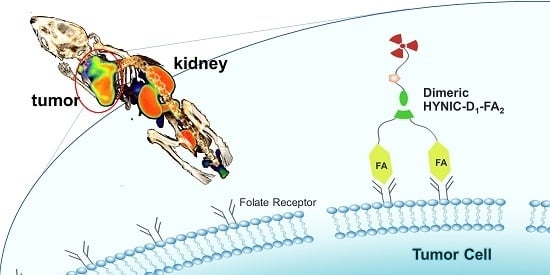Synthesis and Evaluation of 99mTc-Labeled Dimeric Folic Acid for FR-Targeting
Abstract
:1. Introduction
2. Results
2.1. Chemistry and Radiolabeling
2.2. In Vitro Experiments
2.3. Biodistribution Study
2.4. Static Imaging Study
2.5. Dynamic Imaging Study
3. Discussion
4. Materials and Methods
4.1. Reagents and Materials
4.2. Synthetic Route to HYNIC-D1-FA2
4.2.1. Reaction 1
Preparation of FA-NHS
Preparation of Propargyl-PAMAM Dendrons (D1)
Preparation of D1-FA2
4.2.2. Reaction 2
Preparation of 3-azidopropyl-1-amine
Preparation of azido HYNIC
4.2.3. Reaction 3
Preparation of HYNIC-D1-FA2
4.3. Radiolabeling
4.4. Octanol/Water Partition Coefficient
4.5. In Vitro Experiments
4.6. Biodistribution Study
4.7. Static SPECT Imaging Study
4.8. Dynamic SPECT Imaging Study
5. Conclusions
Supplementary Materials
Acknowledgments
Author Contributions
Conflicts of Interest
Abbreviations
| FA | folic acid |
| FR | folate receptor |
| HYNIC | 2-hydrazinonicotinic acid |
| BFC | bifunctional chelator |
| DMSO | Dimethyl Sulphoxide |
| DCC | N,N′-Dicyclohexylcarbodiimide |
| NHS | N-Hydroxysuccinimide |
| Tricine | N-tris-(hydroxymethyl)-methylglycine |
| TPPTS | trisodiumtriphenylpho-sphine-3,30,3″-trisulfonate |
| PEG | poly-(ethylene glycol) |
| PAMAM | polyamidoamine |
| PMX | pemetrexed |
| SPECT | single photon emission computed tomography |
| RGD | cyclic arginine-glycine-aspartic acid peptides |
| 99mTc | technetium-99m |
| MRI | magnetic resonance imaging |
| PB | phosphate buffer |
| ITLC-SG | Instant thin-layer chromatography silica gel strips |
| TLC | thin-layer chromatography |
| RCP | radiochemical purity |
| SA | specific activity |
| %ID/g | percentage of injected dose per gram |
| TACs | time-activity curves |
| ROIs | regions of interests |
| T/NT | tumor-to-nontarget tissue |
| 3D | three-dimensional |
| HPLC | High Performance Liquid Chromatography |
| CT | computed tomography |
| 18F-FDG | 18F-fluorodeoxyglucose |
| p.i. | post-injection time |
References
- Gnanasegaran, G.; Ballinger, J.R. Molecular imaging agents for SPECT (and SPECT/CT). Eur. J. Nucl. Med. Mol. Imaging 2014, 41 (Suppl. 1), S26–S35. [Google Scholar] [CrossRef] [PubMed]
- Bandara, N.A.; Hansen, M.J.; Low, P.S. Effect of receptor occupancy on folate receptor internalization. Mol. Pharm. 2014, 11, 1007–1013. [Google Scholar] [CrossRef] [PubMed]
- Vlahov, I.R.; Leamon, C.P. Engineering Folate-Drug Conjugates to Target Cancer: From Chemistry to Clinic. Bioconjugate Chem. 2012, 23, 1357–1369. [Google Scholar] [CrossRef] [PubMed]
- Ke, C.Y.; Mathias, C.J.; Green, M.A. Folate-receptor-targeted radionuclide imaging agents. Adv. Drug Deliv. Rev. 2004, 56, 1143–1160. [Google Scholar] [CrossRef] [PubMed]
- Muller, C. Folate-based radiotracers for PET imaging-update and perspectives. Molecules 2013, 18, 5005–5031. [Google Scholar] [CrossRef] [PubMed]
- Muller, C.; Schibli, R. Folic acid conjugates for nuclear imaging of folate receptor-positive cancer. J. Nucl. Med. 2011, 52. [Google Scholar] [CrossRef] [PubMed]
- Kim, M.H.; Kim, W.H.; Kim, C.G.; Kim, D.W. Synthesis and Evaluation of 99mTc-Labeled Folate-Tripeptide Conjugate as a Folate Receptor-Targeted Imaging Agent in a Tumor-Bearing Mouse Model. Nucl. Med. Mol. Imaging 2015, 49, 200–207. [Google Scholar] [CrossRef] [PubMed]
- Guo, W.; Jing, H.; Yang, W.; Guo, Z.; Feng, S.; Zhang, X. Radiolabeling of folic acid-modified chitosan with 99mTc as potential agents for folate-receptor-mediated targeting. Bioorg. Med. Chem. Lett. 2011, 21, 6446–6450. [Google Scholar] [CrossRef] [PubMed]
- Jing, H.; Guo, Z.; Guo, W.; Yang, W.; Xu, P.; Zhang, X. Synthesis and characterization of folic acid modified water-soluble chitosan derivatives for folate-receptor-mediated targeting. Bioorg. Med. Chem. Lett. 2012, 22, 3418–3424. [Google Scholar] [CrossRef] [PubMed]
- Benchaala, I.; Mishra, M.K.; Wykes, S.M.; Hali, M.; Kannan, R.M.; Whittum-Hudson, J.A. Folate-functionalized dendrimers for targeting Chlamydia-infected tissues in a mouse model of reactive arthritis. Int. J. Pharm. 2014, 466, 258–265. [Google Scholar] [CrossRef] [PubMed]
- Guo, Z.; Zhang, P.; Song, M.; Wu, X.; Liu, C.; Zhao, Z.; Lu, J.; Zhang, X. Synthesis and preliminary evaluation of novel 99mTc-labeled folate derivative via click reaction for SPECT imaging. Appl. Radiat. Isotopes 2014, 91, 24–30. [Google Scholar] [CrossRef] [PubMed]
- Zhou, Y.; Kim, Y.S.; Lu, X.; Liu, S. Evaluation of 99mTc-labeled cyclic RGD dimers: Impact of cyclic RGD peptides and 99mTc chelates on biological properties. Bioconjugate Chem. 2012, 23, 586–595. [Google Scholar] [CrossRef] [PubMed]
- Dijkgraaf, I.; Kruijtzer, J.A.; Liu, S.; Soede, A.C.; Oyen, W.J.; Corstens, F.H.; Liskamp, R.M.; Boerman, O.C. Improved targeting of the αvβ3 integrin by multimerisation of RGD peptides. Eur. J. Nucl. Med. Mol. Imaging 2007, 34, 267–273. [Google Scholar] [CrossRef] [PubMed]
- Li, Z.B.; Cai, W.; Cao, Q.; Chen, K.; Wu, Z.; He, L.; Chen, X. (64)Cu-labeled tetrameric and octameric RGD peptides for small-animal PET of tumor αvβ3 integrin expression. J. Nucl. Med. 2007, 48, 1162–1171. [Google Scholar] [CrossRef] [PubMed]
- Zhou, Y.; Kim, Y.S.; Chakraborty, S.; Shi, J.; Gao, H.; Liu, S. 99mTc-labeled cyclic RGD peptides for noninvasive monitoring of tumor integrin αvβ3 expression. Mol. Imaging 2011, 10, 386–397. [Google Scholar] [PubMed]
- Singh, P.; Gupta, U.; Asthana, A.; Jain, N.K. Folate and Folate-PEG-PAMAM Dendrimers: Synthesis, Characterization, and Targeted Anticancer Drug Delivery Potential in Tumor Bearing Mice. Bioconjugate Chem. 2008, 19, 2239–2252. [Google Scholar] [CrossRef] [PubMed]
- Yu, H.; Nie, Y.; Dohmen, C.; Li, Y.; Wagner, E. Epidermal Growth Factor-PEG Functionalized PAMAM-Pentaethylenehexamine Dendron for Targeted Gene Delivery Produced by Click Chemistry. Biomacromolecules 2011, 12, 2039–2047. [Google Scholar] [CrossRef] [PubMed] [Green Version]
- Lee, J.W.; Kim, H.J.; Han, S.C.; Kim, J.H.; Jin, S.-H. Designing poly(amido amine) dendrimers containing core diversities by click chemistry of the propargyl focal point poly(amido amine) dendrons. J. Polym. Sci. Polym. Chem. 2008, 46, 1083–1097. [Google Scholar] [CrossRef]
- Zhang, Z.; Rong, F.; Niu, S.; Xie, Y.; Wang, Y.; Yang, H.; Fu, D. Investigation the effects of nano golds on the fluorescence properties of the sectorial poly(amidoamine) (PAMAM) dendrimers. Appl. Surf. Sci. 2010, 256, 7194–7199. [Google Scholar] [CrossRef]
- Meszaros, L.K.; Dose, A.; Biagini, S.C.G.; Blower, P.J. Hydrazinonicotinic acid (HYNIC)-Coordination chemistry and applications in radiopharmaceutical chemistry. Inorg. Chim. Acta 2010, 363, 1059–1069. [Google Scholar] [CrossRef]
- Guo, H.; Xie, F.; Zhu, M.; Li, Y.; Yang, Z.; Wang, X.; Lu, J. The synthesis of pteroyl-lys conjugates and its application as Technetium-99m labeled radiotracer for folate receptor-positive tumor targeting. Bioorg. Med. Chem. Lett. 2011, 21, 2025–2029. [Google Scholar] [CrossRef] [PubMed]
- Reber, J.; Struthers, H.; Betzel, T.; Hohn, A.; Schibli, R.; Muller, C. Radioiodinated folic acid conjugates: Evaluation of a valuable concept to improve tumor-to-background contrast. Mol. Pharm. 2012, 9, 1213–1221. [Google Scholar] [CrossRef] [PubMed]
- Ghobril, C.; Lamanna, G.; Kueny-Stotz, M.; Garofalo, A.; Billotey, C.; Felder-Flesch, D. Dendrimers in nuclear medical imaging. New J. Chem. 2012, 36, 310–323. [Google Scholar] [CrossRef]
- Mathias, C.J.; Hubers, D.; Low, P.S.; Green, M.A. Synthesis of [99mTc]DTPA-folate and its evaluation as a folate-receptor-targeted radiopharmaceutical. Bioconjugate Chem. 2000, 11, 253–257. [Google Scholar] [CrossRef]
- Trump, D.P.; Mathias, C.J.; Yang, Z.; Low, P.S.; Marmion, M.; Green, M.A. Synthesis and evaluation of 99mTc(CO)3-DTPA-folate as a folate-receptor-targeted radiopharmaceutical. Nucl. Med. Biol. 2002, 29, 569–573. [Google Scholar] [CrossRef]
- Jie, L.; Yan, P.; Fang, X.; Guo, H.; Yan, L.; Zhi, Y.; Wang, X. Synthesis and in vitro/in vivo evaluation of 99mTc-labeled folate conjugates for folate receptor imaging. Nucl. Med. Biol. 2011, 38, 557–565. [Google Scholar]
- Zhang, Y.; Sun, Y.; Xu, X.; Zhu, H.; Huang, L.; Zhang, X.; Zhang, X.; Qi, Y.; Shen, Y. Radiosynthesis and micro-spect imaging of 99mTc-dendrimer poly(amido)-amine folic acid conjugate. Bioorg. Med. Chem. Lett. 2010, 20, 927–931. [Google Scholar] [CrossRef] [PubMed]
- Zhang, Y.; Sun, Y.; Xu, X.; Zhang, X.; Zhu, H.; Huang, L.; Qi, Y.; Shen, Y. Synthesis, biodistribution, and microsingle photon emission computed tomography (SPECT) imaging study of technetium-99m labeled pegylated dendrimer poly(amidoamine) (PAMAM)-folic acid conjugates. J. Med. Chem. 2010, 53, 3262–3272. [Google Scholar] [CrossRef] [PubMed]
- Müller, C.; Schibli, R.; Krenning, E.P.; De, J.M. Pemetrexed improves tumor selectivity of 111In-DTPA-folate in mice with folate receptor-positive ovarian cancer. J. Nucl. Med. 2008, 49, 623–629. [Google Scholar] [CrossRef] [PubMed]
- Müller, C.; Schibli, R.; Forrer, F.; Krenning, E.P.; Jong, M.D. Dose-dependent effects of (anti)folate preinjection on 99mTc-radiofolate uptake in tumors and kidneys. Nucl. Med. Biol. 2007, 34, 603–608. [Google Scholar] [CrossRef] [PubMed]
- Sample Availability: Not available.
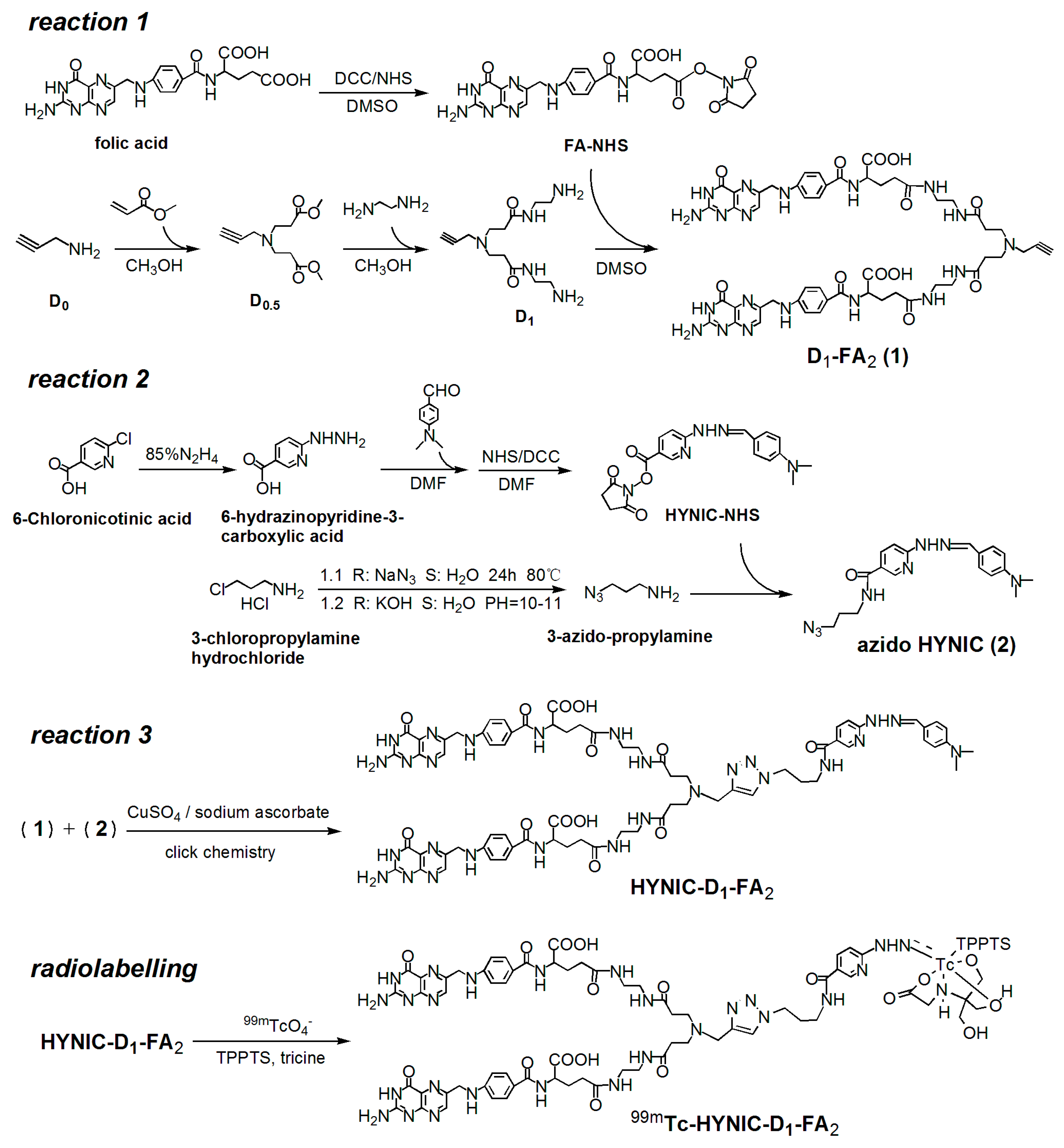
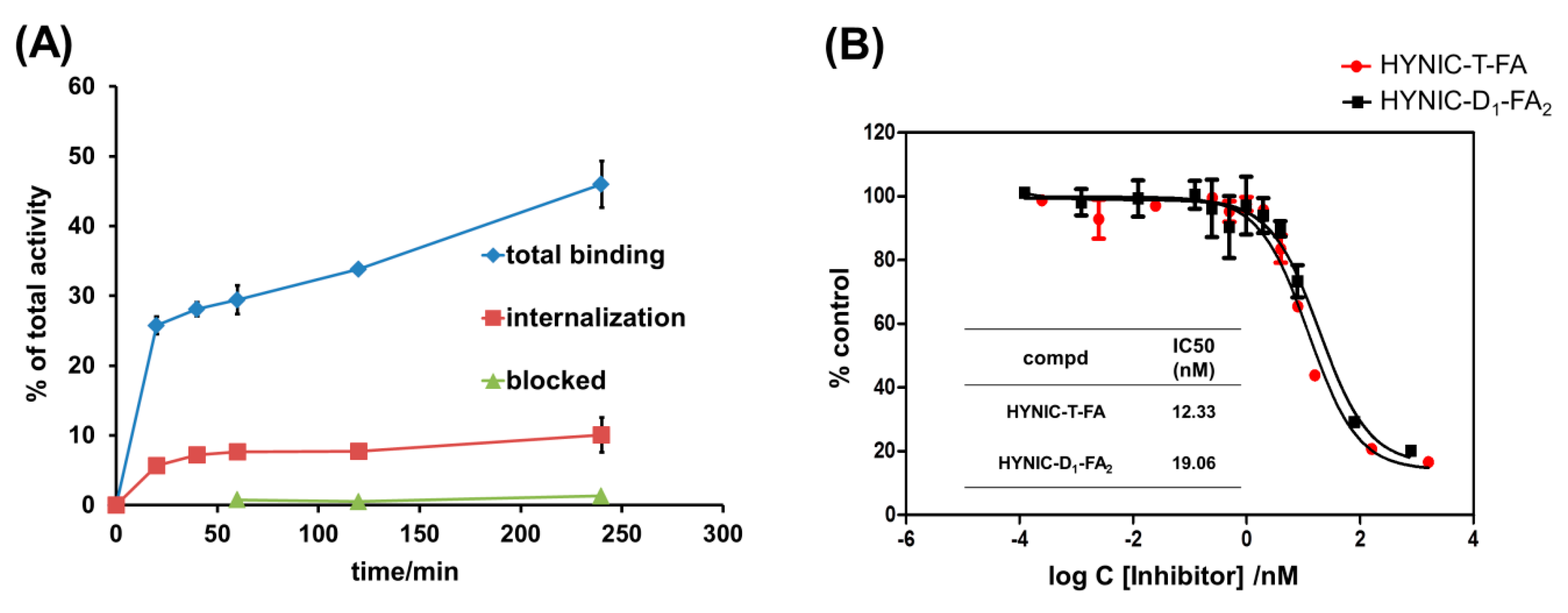
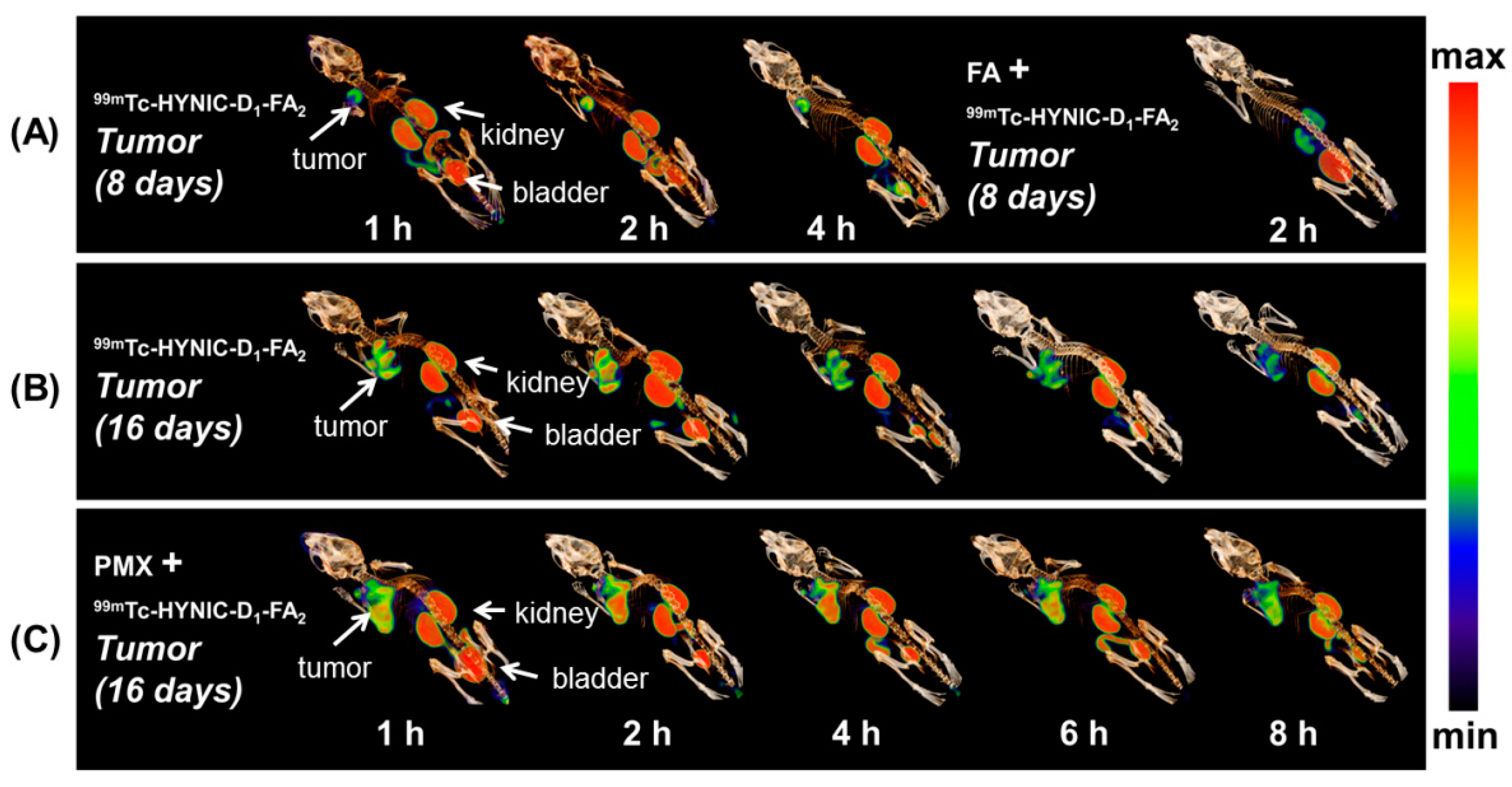
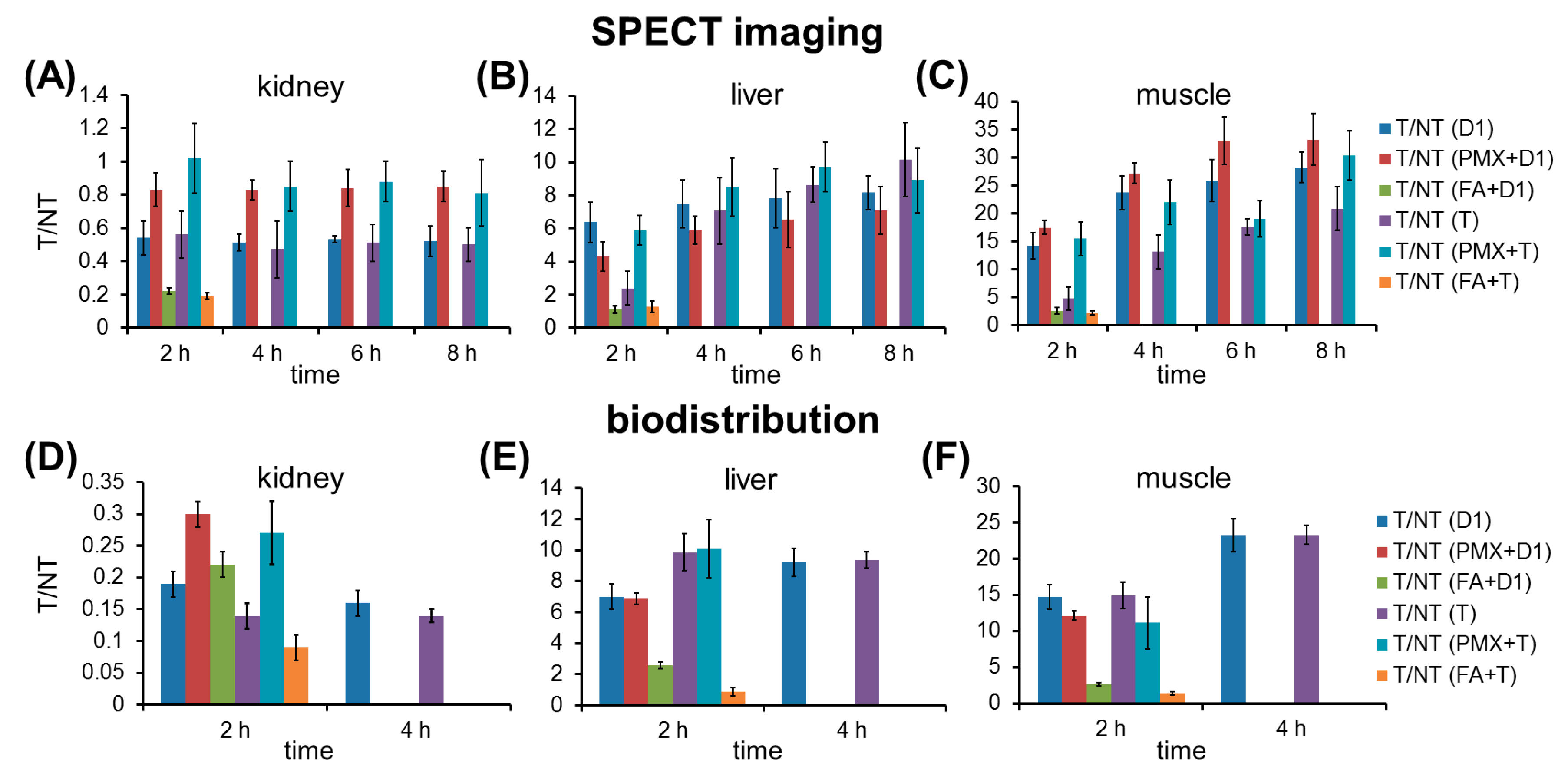
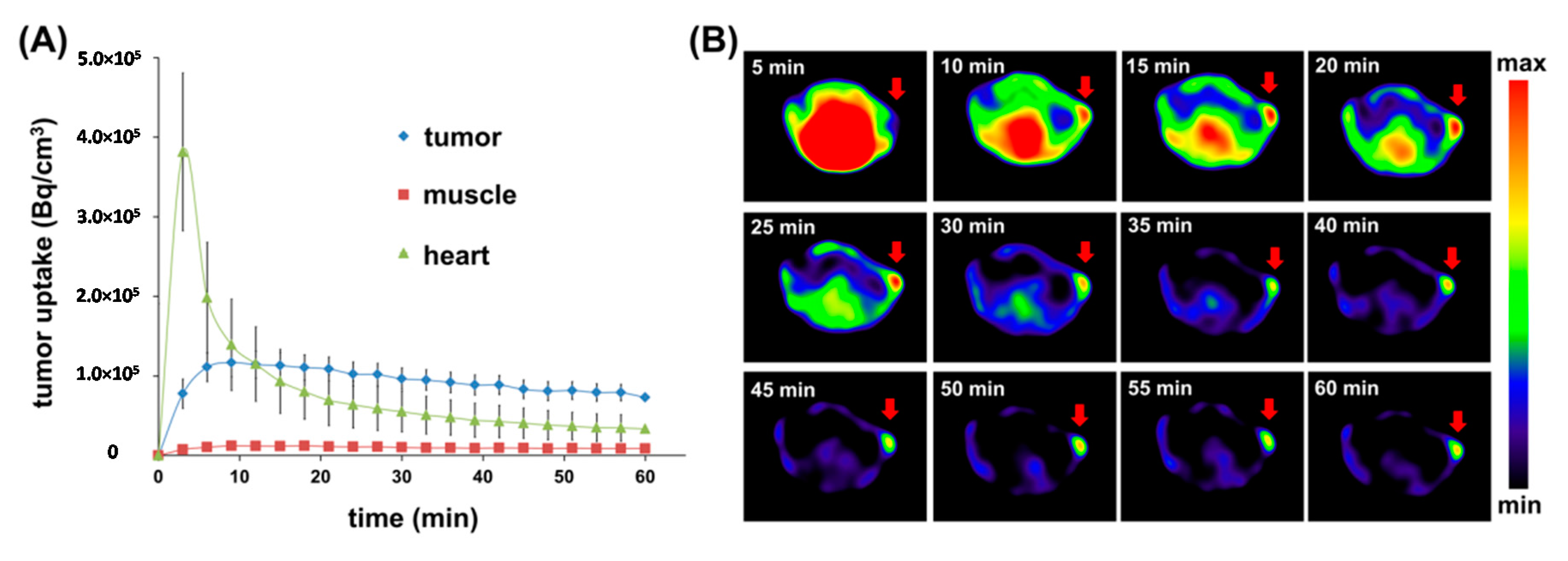
| Derivative | FA/HYNIC | Molecular Formula | Mw | Log P |
|---|---|---|---|---|
| HYNIC-T-FA | 1/1 | C40H44N16O6 | 844.4 | −2.40 ± 0.17 |
| HYNIC-D1-FA2 | 2/1 | C69H81N27O13 | 1495.7 | −2.52 ± 0.13 |
| Tissues | Post-Injection Time | |||
|---|---|---|---|---|
| 2 h | 4 h | 2 h w/ PMX * | 2 h w/ FA ** | |
| Heart | 1.11 ± 0.18 | 0.90 ± 0.08 | 0.75 ± 0.10 | 0.82 ± 0.12 |
| Liver | 1.45 ± 0.56 | 1.01 ± 0.11 | 1.23 ± 0.14 | 0.88 ± 0.10 |
| Lung | 1.59 ± 0.62 | 0.97 ± 0.11 | 1.05 ± 0.31 | 1.27 ± 0.18 |
| Kidney | 54.09 ± 2.21 | 56.69 ± 3.12 | 28.07 ± 2.42 | 10.46 ± 0.04 |
| Spleen | 0.95 ± 0.05 | 0.78 ± 0.31 | 0.85 ± 0.18 | 0.99 ± 0.14 |
| Stomach | 1.03 ± 0.11 | 0.65 ± 0.09 | 0.73 ± 0.03 | 0.46 ± 0.03 |
| Bone | 1.11 ± 0.07 | 0.98 ± 0.07 | 0.76 ± 0.16 | 0.91 ± 0.21 |
| Muscle | 0.69 ± 0.04 | 0.40 ± 0.07 | 0.70 ± 0.10 | 0.86 ± 0.12 |
| Intestines | 0.80 ± 0.12 | 0.63 ± 0.07 | 0.63 ± 0.11 | 0.76 ± 0.16 |
| Blood | 0.66 ± 0.19 | 0.58 ± 0.04 | 0.66 ± 0.16 | 0.96 ± 0.20 |
| Tumor | 10.16 ± 1.16 | 9.30 ± 0.91 | 8.47 ± 0.45 | 2.26 ± 0.19 |
| Tumor/Muscle | 14.72 | 23.25 | 12.10 | 2.63 |
| Tumor/Kidney | 0.19 | 0.16 | 0.30 | 0.22 |
| Blood | Muscle | Tumor | Kidneys | Liver | |
|---|---|---|---|---|---|
| 111In-DTPA-folate [24] | 0.03 ± 0.02 | 0.71 ± 0.26 | 2.9 ± 0.9 | 25.0 ± 6.0 | 0.64 ± 0.23 |
| 99mTc-DTPA-folate [24] | 0.19 ± 0.05 | 0.70 ± 0.14 | 2.9 ± 0.8 | 21.0 ± 3.0 | 1.05 ± 0.30 |
| 99mTc(CO)3-DTPA-folate [25] | 0.37 ± 0.02 | 2.40 ± 0.10 | 3.3 ± 0.2 | 47.0 ± 5.0 | 7.60 ± 0.50 |
| 99mTc(HYNIC-lys-pteroyl)(tricine/TPPTS) [21] | 0.31 ± 0.07 | 0.98 ± 0.17 | 7.9 ± 1.4 | 88.6 ± 9.2 | 2.08 ± 0.18 |
| 99mTc(HYNIC-NHHN-FA)(tricine/TPPMS) [26] | 0.06 ± 0.00 | 0.17 ± 0.07 | 0.19 ± 0.05 | 3.6 ± 1.4 | 0.14 ± 0.07 |
| 99mTc(HYNIC-NHHN-FA)(tricine/TPPTS) [26] | 0.30 ± 0.07 | 0.81 ± 0.23 | 9.8 ± 1.7 | 114.9 ± 8.1 | 0.60 ± 0.13 |
| 99mTc-HYNIC-T-FA [11] | 0.37 ± 0.05 | 0.35 ± 0.11 | 8.14 ± 0.5 | 57.72 ± 4.5 | 0.85 ± 0.11 |
| 99mTc-HYNIC-D1-FA2 | 0.58 ± 0.04 | 0.40 ± 0.07 | 9.30 ± 0.91 | 56.69 ± 3.12 | 1.01 ± 0.11 |
© 2016 by the authors. Licensee MDPI, Basel, Switzerland. This article is an open access article distributed under the terms and conditions of the Creative Commons Attribution (CC-BY) license ( http://creativecommons.org/licenses/by/4.0/).
Share and Cite
Guo, Z.; Gao, M.; Song, M.; Shi, C.; Zhang, P.; Xu, D.; You, L.; Zhuang, R.; Su, X.; Liu, T.; et al. Synthesis and Evaluation of 99mTc-Labeled Dimeric Folic Acid for FR-Targeting. Molecules 2016, 21, 817. https://doi.org/10.3390/molecules21060817
Guo Z, Gao M, Song M, Shi C, Zhang P, Xu D, You L, Zhuang R, Su X, Liu T, et al. Synthesis and Evaluation of 99mTc-Labeled Dimeric Folic Acid for FR-Targeting. Molecules. 2016; 21(6):817. https://doi.org/10.3390/molecules21060817
Chicago/Turabian StyleGuo, Zhide, Mengna Gao, Manli Song, Changrong Shi, Pu Zhang, Duo Xu, Linyi You, Rongqiang Zhuang, Xinhui Su, Ting Liu, and et al. 2016. "Synthesis and Evaluation of 99mTc-Labeled Dimeric Folic Acid for FR-Targeting" Molecules 21, no. 6: 817. https://doi.org/10.3390/molecules21060817
APA StyleGuo, Z., Gao, M., Song, M., Shi, C., Zhang, P., Xu, D., You, L., Zhuang, R., Su, X., Liu, T., Du, J., & Zhang, X. (2016). Synthesis and Evaluation of 99mTc-Labeled Dimeric Folic Acid for FR-Targeting. Molecules, 21(6), 817. https://doi.org/10.3390/molecules21060817





